While there have long been diehard fans of vintage and antique furniture, the furniture shortage and resulting delivery delay throughout the COVID-19 pandemic has made higher-end secondhand shopping even more competitive. And with the increased demand has come a flood of fakes, Sydney Gore writes in an article for Architectural Digest.
Even if you’re considering purchasing a piece of vintage furniture because you like the look of it and/or it fits your needs and don’t necessarily care who made it, you still want to avoid buying a knockoff, as they can be poorly constructed. And if you are paying top-dollar to get an authentic Knoll chair, for instance, then you definitely want to make sure it’s real.
Fortunately, in her article, Gore provides tips for spotting knockoff vintage furniture (along with a bunch of other helpful and interesting information). Here are a few to keep in mind the next time you’re furniture shopping.
Look for ‘Made in Italy’ stickers
According to Gore, “’Made in Italy’ stickers are the new ‘Made in China’ stamp.” Of course, that’s not saying that any vintage furniture you find with a “Made in Italy” sticker is a dupe or of poor quality, but over the past several years, Italy has become a hub of manufacturing unauthorised copies of high-end furniture. If you spot a sticker, do some research into where that particular designer’s furniture is actually made.
Don’t be afraid to ask plenty of questions
This one’s fairly obvious, but whether you’re purchasing vintage furniture online (via places like Chairish, 1stdibs, Instagram, or Facebook Marketplace) or in-person, ask all the questions. Don’t worry about sounding like you don’t know what you’re talking about — if anything, it’s the opposite.
“Any reputable furniture dealer should be able to confidently prove why one of their pieces is authentic and indeed a vintage piece,” the anonymous man behind the @northwest_mcm_wholesale Instagram account told Architectural Digest. “If a seller references a 1stdibs listing or pulls up the same item from another store, you better keep asking questions. This is not authentication.”
Ask about the finish
There’s one specific question that the @northwest_mcm_wholesale guy recommends asking to help you suss out whether case goods or bedroom furniture is authentic: “Is the finish original?”
“If the seller promises that a piece has been refinished or fully restored, I would hit the pause button,” he says. It’s not that restoring a piece of furniture is necessarily a bad thing, but he points out that there’s a difference between doing it “to match the original factory finish as closely as possible using contemporary means” and if it’s “restored according to the whim of a clueless dealer who is trying to make a quick buck.”

Leave a Reply
You must be logged in to post a comment.